 |
Thanks to all 3,804 participants!
Here are the detailed survey results. How does your organization measure up?
2013 Holiday Season
Thanksgiving
When asked which days will be paid holidays for their employees at Thanksgiving in 2013, 95.5% of survey participants indicated that Thanksgiving Day will be a paid holiday. Additionally, 65.1% will provide the day after Thanksgiving as a paid holiday.
A very small minority, 1.7%, will offer no paid time off during Thanksgiving. With 4.4% of responses, the “other” bucket contains a mishmash of answers, including:
- Exempt employees receive the day after but hourly employees don’t.
- Half-day Wednesday, the day before Thanksgiving.
- The day after Thanksgiving Day is a floating holiday, and employees choose one of the three floating day holiday choices for their paid holiday vacation day.
- Friday we are closed but not paid.
- With our PTO plan, folks choose their own days off.
Compensation.BLR.com, now thoroughly reved with easier navigation and more complete compensation information, will tell you what’s being paid right in your state—or even metropolitan area—for hundreds of jobs. Try it at no cost and get a complimentary special report. Read more.
Christmas
For the 2013 Christmas season, 94% of survey respondents will provide December 25th as a paid holiday, and 39% (down from 43.6% in 2012) will offer the 24th as well. Boxing Day, December 26th, will be a paid holiday for 5.7%, and 3.3% (down from 4.8% in 2012) will provide the entire week off with pay. As in 2012, no paid time off will be offered by 1.2%.
The “other” bucket, at 13.2%, for this question in our survey, reveals a mixture of paid-time-off options, including:
- Only salaried employees get paid for Christmas.
- Bargaining unit also gets an extra 8-hours-pay for Christmas.
- Half-day on Christmas Eve.
- Either the day before Christmas or the day after depending on how the holiday falls.
- If the holiday falls on a day that is not a regularly scheduled workday, no compensation for the day will be paid.
- PTO and time and a half for those who work.
- Only corporate employees get paid.
- We are closed, employees can take PTO.
New Year’s
Employers’ plans for paid time off during the New Year’s holiday paint a slightly different picture with 95.2% providing New Year’s Day as a paid holiday, but only 16.2% offering New Year’s Eve as paid time off. Only 1.1% will offer New Year’s week as paid time off, and 2% will offer no paid holiday. The ubiquitous “other” bucket at 7.1% contains a plethora of responses, including:
- Leave early on New Year’s Eve.
- New Year’s Eve is a “Floating Holiday,” and employees may choose it as their Floating Holiday.
- Only Salaried Employees get paid for New Year’s Day.
- One location of a multilocation corporation will receive pay for New Year’s Eve.
- Full-time employees who work the holiday may take another day in lieu of this holiday.
- If working after 3 on New Year’s Eve, time and a half, same for New Year’s Day.
- With our PTO plan, folks choose their own days off.
- Monday and Tuesday (12/30 and 12/31) are paid holidays for employees who have worked two Saturdays during the calendar year.

2014 Paid Holidays
How Many Holidays Are Offered?
When asked how many paid holidays their employees will receive in 2014, 2.9% of survey participants indicated their employees will receive 1 to 5 days, 35.4% will receive 6 to 8 paid holidays, and 45.1% will receive 9 to 11 days. Twelve or more paid holidays will be on deck for 13.2%, and 1.2% will not receive paid holidays in 2014.
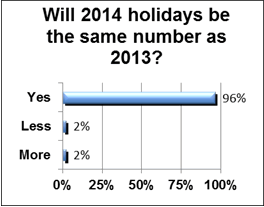
Which Holidays Are Offered?
Memorial Day, Independence Day, Labor Day, Thanksgiving Day, Christmas Day, and New Year’s Day will be offered as paid holidays by at least 94% of survey participants in 2014.
Martin Luther King Jr. Day and Presidents’ Day will be paid holidays for 32% and 32.2%, respectively. Columbus Day is a paid day off for 12.5%, and Boxing Day will qualify as a paid holiday for 9.2% (up from 4.3% in 2013).
A peek into the “other” box, selected by 19.2% of survey participants, reveals myriad paid holidays, including:
- 4 hours of Christmas shopping
- Arbor Day
- Cesar Chavez Day
- Civic Day
- Day after Independence Day
- EE Appreciation Day
- Employee’s birthday
- First day of hunting season
- Friday before Labor Day
- Lincoln’s Birthday
- Mardi Gras Day
- Solar Appreciation Day
- Take a Hike Day
Holiday Practices
Holiday Gifts Policies
Only gifts of nominal value may be accepted by employees from parties outside their organization (e.g., vendors, clients) for 54.6%. No employee gift policy is the norm for 25.4%, and no gifts may be accepted is the rule for 16.6%.
Holiday Pay Practices
No employees work on holidays for 29.6% of survey participants. Employees do work on holidays and receive holiday pay plus time and a half for hours worked for 24%, and 7.9% pay holiday pay plus double time. Only regular pay is received for 14% and another day off with pay is the norm for 8.2%.
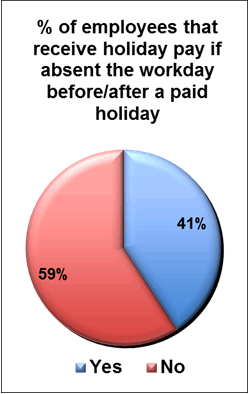
Who Gets First Dibs on Holidays?
When it comes to deciding which employees get priority in deciding their days off during the holidays, 25.1% leave it up to the supervisor and 23.8% go with whoever asks first. It’s not a problem, and everyone gets what he or she wants for 13.9%, but for 9.4%, employees take turns from year to year. A formal system based on seniority is in place for 8.5%, and 10.6% use an informal seniority/ranking system.
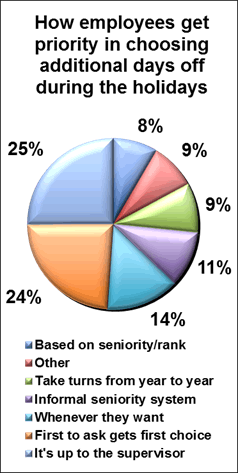
Unrecognized Holidays
For 38.3% of survey participants, fewer than 5% of employees use paid time off for religious days not recognized as paid holidays, and for 24.5% of participants, no employees use such time.
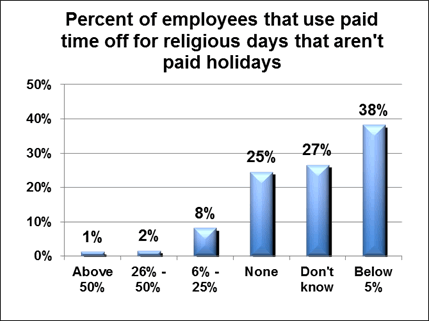
Deck the Halls
If their holiday decorations are within reason, 82.6% of survey participants allow employees to display them. Another 12.1% allow employees to display whatever they want. Only 3.2% forbid employees from holiday decorating.
Along those same lines, 47.9% provide/display holiday themed decorations in common areas at their facility, and 34.1% do so only during Christmas. No company-sponsored decorations are displayed by 15.5%.
Of the 70% of survey participants that host year-end or holiday parties for their employees, 57% go off-site, and 36% keep the festivities in-house. Alcoholic beverages are available for 49%, and 46% allow spouses and/or significant others to attend the celebration. How organizations celebrate the holidays hasn’t been impacted by the economic downturn of 2008 for 50%.
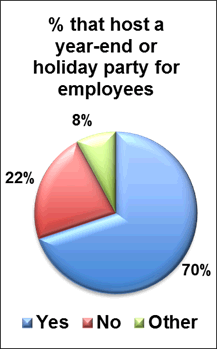
Some of the ways survey participants will be celebrating the holidays this year include:
- We designate a day for each department to bring food for the 5 days before Christmas. For example, Accounting brings something on Monday, Operations brings something on Tuesday, and so forth.
- Year-end/Christmas celebration is now on-site with a potluck for employees only. We were going to switch back to a restaurant dinner, but employees requested to stay with the potluck lunch on-site.
- We have a talent competition for employees that has been very positively received and attended. We expect to continue this annual event.
- We create a company float for the annual Christmas parade of lights. Employees and families help build, decorate, and ride on the float. Then a pizza/pasta party after the parade at our main office.
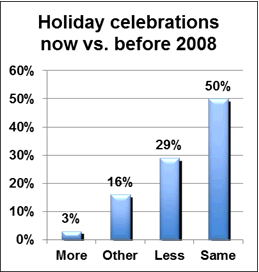
Charitable Activities
Though 8% have yet to decide about this year, charitable activities are sponsored by or participated in for 65%. The types of activities are varied with sponsoring a food drive topping the list at 55%. Volunteer work or visits by employees during working hours ends the list at 21%. The complete list follows:
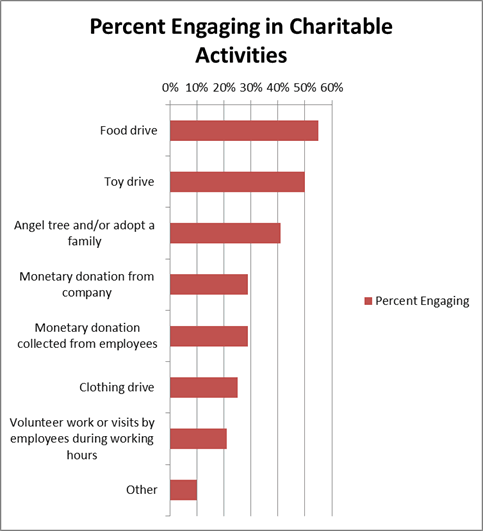
“Other” includes activities such as operating a “Holiday Store” for homeless families to provide gifts for their children, adoption of families within the company that are in need, company match of employee donations, donation of gift certificates for prizes at charity auctions, and gifts for nursing home residents.
Survey Participants’ Data
A total of 3,804 individuals participated in this survey, which was conducted in October 2013. Of those who identified themselves, 54.3% represent privately owned companies, 10.7% are with public entities, and 27.6% work for government or nonprofit organizations.
The majority (64%) of our survey respondents provide HR services to a workforce of 1–250 employees. Another 12.7% provide guidance to 251–500 employees at their organizations, and 9.1% have a workforce of 501–1,000 employees. Companies with more than 1,000 employees account for 14.2% of survey participants.
Less than 8% of the employers surveyed have a 50–100% unionized workforce. Also, 86.1% have a workforce that is less than 10% union employees. Less than 26% of the respondents have a workforce of more than 50% exempt employees.
Over half (65.3%) of the participants are in service industries; 22.5% are in agriculture, forestry, construction, manufacturing, or mining; 8.1% are in wholesale, retail, transportation, or warehousing; and 4.1% are in real estate or utilities.
HR managers and directors account for 46.5% of the survey participants who self-identified, other HR professionals make up 26.6%, 5.1% are benefits professionals, and 21.9% are in other areas with HR responsibilities.
